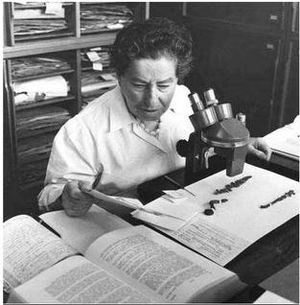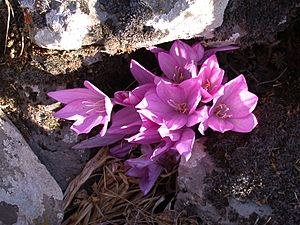Naomi Feinbrun-Dothan facts for kids
Quick facts for kids
Naomi Feinbrun
|
|
|---|---|
 |
|
| Born |
Naomi Feinbrun
17 April 1900 Moscow, Russia
|
| Died | 8 March 1995 (aged 94) Jerusalem
|
| Nationality | Russian then Israeli |
| Alma mater | Moscow University, University of Cluj, Hebrew University of Jerusalem |
| Known for | Taxonomy, phytogeography, genetics |
| Awards | Gold medal from Optima (1986), Israel Prize (1991) |
| Scientific career | |
| Fields | Botany |
| Academic advisors | Alexander Eig |
| Influences | Alexander Eig |
| Author abbrev. (botany) | Feinbrun |
Naomi Feinbrun-Dothan (born April 17, 1900 – died March 8, 1995) was a famous botanist from Israel. She was born in Russia. She worked at the Hebrew University of Jerusalem.
Naomi studied the plants of Israel very closely. She wrote many articles and several important books about plants. Just after her 91st birthday, she won the 1991 Israel Prize. This award was for her amazing work studying the land of Israel.
She is known for naming several plants. These include Allium truncatum, Allium dumetorum, and Iris regis-uzziae.
Contents
Naomi's Early Life and Education
Naomi Feinbrun was born in Moscow, Russia, in 1900. Her parents, Rachel and Aharon Feinbrun, were part of a group called Hovevei Zion. This group supported Jewish people moving to Palestine.
Naomi had an older sister, Shulamit, and two younger brothers, Miron and Moshe. Her family lived in Kishinev, a city in Bessarabia. She went to an elementary school where she learned Hebrew. She also attended a Jewish girls’ high school there.
In 1907, her family moved back to Moscow. After finishing high school in 1918, she started studying at Moscow University.
Moving to Palestine
In 1920, Naomi's family moved back to Bessarabia. She continued her studies at the University of Cluj in Romania. In 1923, she earned her first degree in botany, which is the study of plants. After graduating, she became a teacher. She taught natural sciences at a Jewish girls' high school.
In 1924, Naomi's whole family moved to Palestine. This move is called aliyah. Naomi was 24, so she needed special help to immigrate. A relative helped her by saying she had been a high school student in Tel Aviv.
After getting a recommendation, Naomi started teaching. She worked at a school in Tel Adashim in the Jezreel Valley.
Meeting Her Mentor
In 1925, Naomi went on a study trip for science teachers. The trip was to Tavor Mountain. The guide was a botanist named Alexander Eig. He saw Naomi's talent and encouraged her to do more plant research. He became her mentor and a close colleague.
Naomi Feinbrun-Dothan passed away on March 8, 1995. She died just before her ninety-fifth birthday.
Naomi's Scientific Career
In 1926, Naomi joined the Institute of Agriculture and Natural History in Tel Aviv. This institute was led by Otto Warburg. She worked there part-time as a guest researcher. During this time, she improved her English by studying a book about the plants of Syria, Palestine, and Sinai.
When the Hebrew University of Jerusalem was founded in 1925, the Institute became part of it. Its name changed to the 'Systematic Botany Branch'. Otto Warburg remained its director.
Working in Jerusalem
In 1929, Naomi became an assistant at the university. She moved to Jerusalem with Alexander Eig and Michael Zohary. In 1931, they created the first analytical flora book. This book described and classified plants. It was written in Hebrew and later reprinted in English in 1965.
The university began teaching sciences in the early 1930s. Genetics, the study of how traits are passed down, became a main subject in the Botany Department. Naomi started teaching genetics. This was because of her work in cytology, which is the study of cells.
From 1930 to 1938, Naomi published her plant research in Hebrew or German. After 1938, she began publishing in English.
In 1931, she traveled to the Kaiser Wilhelm Institute in Berlin. She wanted to learn more about genetics. She worked in their 'Department for Hereditary Research'.
Botanical Gardens and Expeditions
Also in 1931, Alexander Eig started the Jerusalem Botanical Gardens. He did this with Michael Zohary and Naomi Feinbrun. The gardens were on Mount Scopus.
In 1933, Naomi joined a group of scientists invited to Iraq. They surveyed the forests of Kurdistan. Their goal was to count trees and suggest ways to protect and plant more forests. Naomi also went on other research trips. She visited Transjordan, the Sinai Peninsula, Lebanon, Cyprus, and Egypt in 1944.
In 1935, she spent two and a half months in Paris. She worked in a lab at the Sorbonne University. When she returned to Palestine, she started teaching genetics and cytology. She was the only one teaching genetics at the Hebrew University until the 1950s.
Publications and Research
In 1936, Alexander Eig started the 'Palestine Journal of Botany Jerusalem'. Naomi and her colleagues published their work in this journal. It was later renamed the 'Israel Journal of Botany'. The first issue included a map of plant regions. This map was based on the many field trips by the three researchers.
Naomi worked on her doctoral paper, called A monographic study of the genus Bellevalia'. She studied the number and shape of chromosomes in plants. She used this information to classify this plant group. Her paper was published in the 'Palestine Journal of Botany'.
In 1938, Dr. Alexander Eig passed away. His two assistants, Michael Zohary and Naomi Feinbrun, continued his important work. They kept documenting the plants of Palestine and caring for the Mount Scopus Botanical Garden.
Naomi received her Ph.D. in 1938. She focused on studying local and Middle Eastern plant species. She grew them in special plots and studied their chromosomes to classify them. This field is called cytotaxonomy.
After 1947, when Israel became a country, Naomi and her brothers changed their family name. She became Naomi Feinbrun-Dothan.
Later Career and Flora Palaestina
In 1953, Naomi spent a year at the herbarium at Kew Gardens in London. A herbarium is a collection of preserved plant specimens. She also visited herbaria in Edinburgh and Geneva. In 1960, she became an associate professor at the university. She was one of only a few women at that high rank.
In 1960, she wrote a book called 'Wild plants in the land of Israel'.
Between 1966 and 1986, she co-wrote four volumes of Flora Palaestina with Professor Michael Zohary. These books are very important. They include ways to identify plants, descriptions of plants, and drawings of native and naturalized plant species in the region.
In the 1970s, Naomi studied some unknown plant bulbs. She identified them as a Greek species. Later, another scientist studied them again. They were found to be a new species. Naomi described this new species in the 'Israeli Journal of Plant Science'. She named it Colchicum feinbruniae after herself.

In 1991, she wrote a new and updated plant guide with Avinoam Danin.
Awards and Recognition
Naomi Feinbrun-Dothan received many awards for her work.
In 1986, she won a gold medal from 'Optima'. This is an international group of botanists who study Mediterranean plants. She received the award for finishing the important Flora Palaestina books.
In 1991, she was given the prestigious Israel Prize. This was for her unique contributions to studying the land of Israel.
Her memory lives on through several plants named in her honor. These include Astragalus feinbruniae (named in 1970), Bellevalia feinbruniae (1970), and Colchicum feinbruniae (1992).
See also
 In Spanish: Naomi Feinbrun para niños
In Spanish: Naomi Feinbrun para niños

